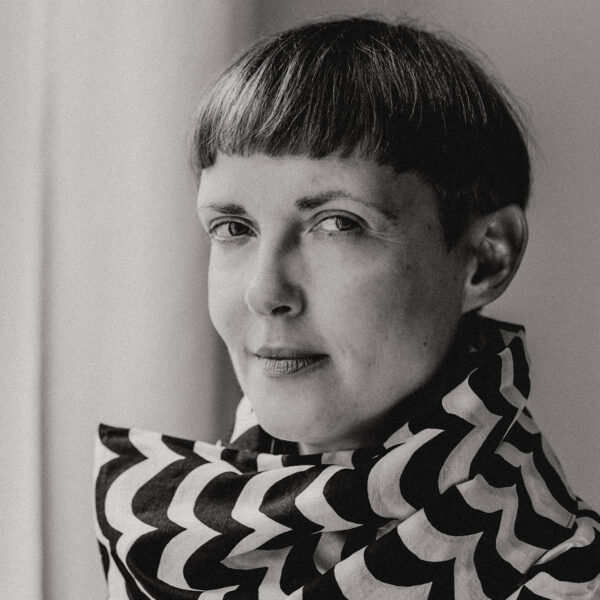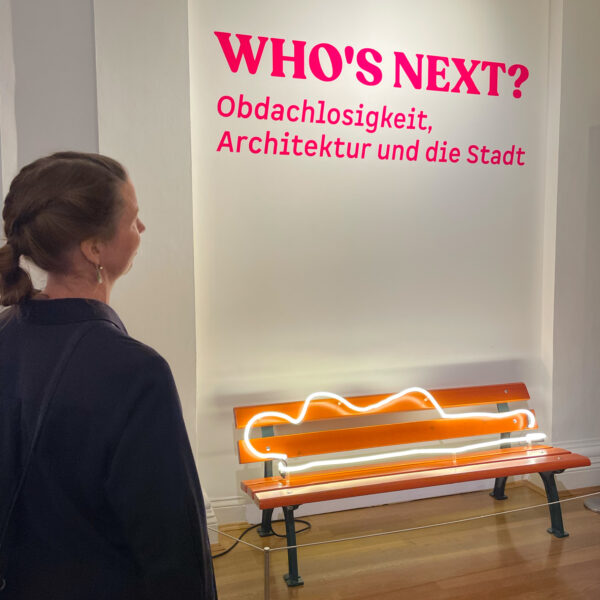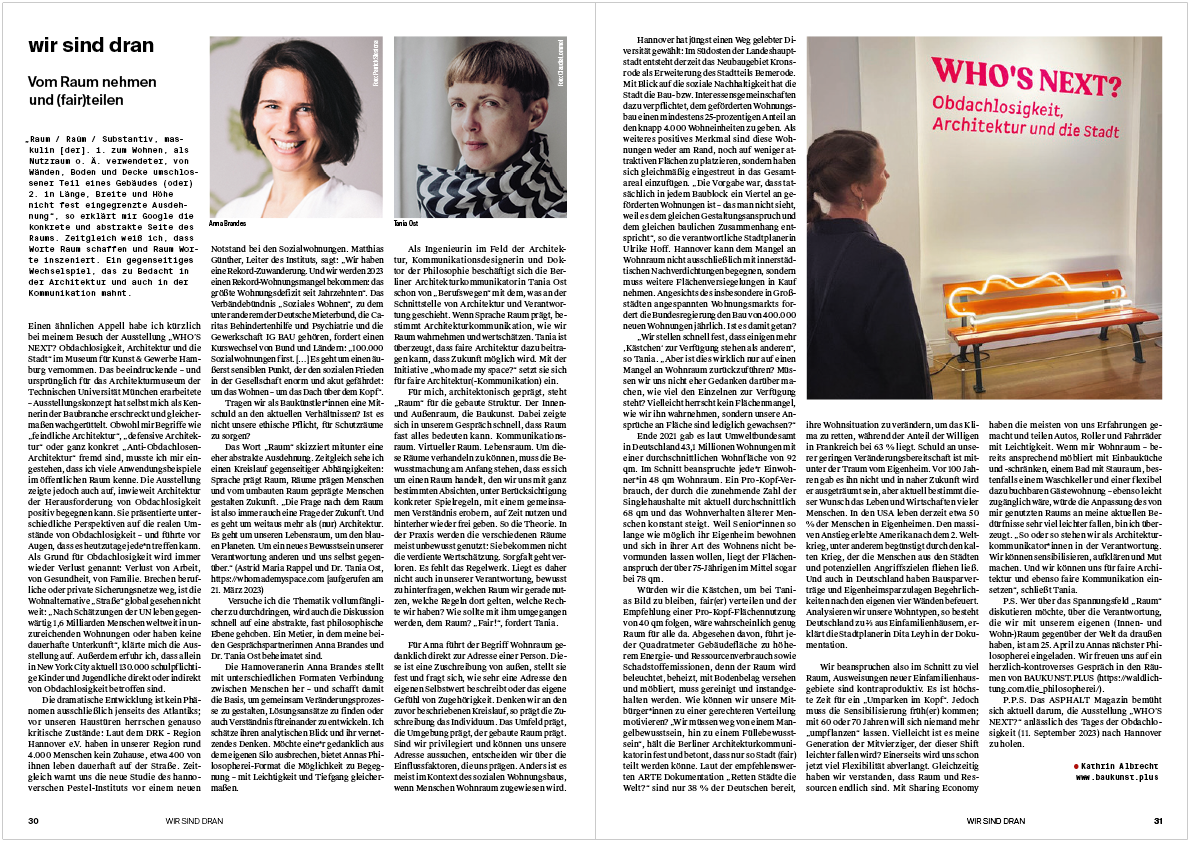
it’s our turn #4
From taking space and sharing (fairly)
“room /ruːm,rʊm/ noun, masculine [the]. 1. part of a building used for living, as a utility room, etc., enclosed by walls, floor, and ceiling (or) 2. extension not firmly delimited in length, width, and height” is how Google explains the concrete and abstract side of space to me. At the same time, I know that words create space and space stages words. A mutual interplay that calls for careful consideration in architecture and in communication.


I recently heard a similar appeal during my visit to the exhibition “WHO’S NEXT? Homelessness, Architecture, and the City” at the Museum für Kunst & Gewerbe Hamburg. The impressive exhibition concept – originally developed for the Architecture Museum of the Technical University of Munich – startled and awakened even me as a connoisseur of the building industry. Although terms such as “hostile architecture,” “defensive architecture,” or quite specifically “anti-homeless architecture” are foreign to me, I had to admit to myself that I know many examples of their application in public space. However, the exhibition also showed the extent to which architecture can positively address the challenge of homelessness. It presented different perspectives on the real circumstances of homelessness – and showed that nowadays it can happen to anyone. Loss is always mentioned as a reason for homelessness: Loss of work, of health, of family. If professional or private safety nets break down, the housing alternative “street” is not far away in global terms: “According to UN estimates, 1.6 billion people worldwide currently live in inadequate housing or have no permanent accommodation”, the exhibition explained to me. I also learned that in New York City alone, 130,000 school-age children and youth are currently directly or indirectly affected by homelessness.
The dramatic development is not a phenomenon exclusively on the other side of the Atlantic; just as critical conditions prevail on our doorsteps: According to the DRK – Region Hannover e.V., around 4,000 people have no home in our region, about 400 of them live permanently on the streets. At the same time, a new study by the Hanover-based Pestel Institute warns us of a new emergency in social housing. Matthias Günther, head of the institute, says: “We have record immigration. And we will have a record housing shortage in 2023: the largest housing deficit in decades.” The “Social Housing” alliance of associations, which includes the German Tenants’ Association, Caritas Behindertenhilfe und Psychiatrie and the IG BAU trade union, demands a change of course from the federal and state governments: “100,000 social housing units first. […] It is about an extremely sensitive point, which endangers the social peace in society enormously and acutely: about housing – about the roof over one’s head”.

Photo: Meldt Albrecht
Are we as building artists partly to blame for the current situation? Is it not our ethical duty to provide shelter?
The word “space” sometimes sketches a rather abstract extension. At the same time, I see a cycle of mutual dependencies: Language shapes space, spaces shape people, and people shaped by enclosed space shape the future. “The question of space is therefore always also a question of the future. And it is about much more than (just) architecture. It is about our living space, about the blue planet. About a new awareness of our responsibility towards others and ourselves.” [1] If I try to penetrate the topic more fully, the discussion is also quickly elevated to an abstract, almost philosophical level. A métier in which my two interlocutors Anna Brandes and Dr. Tania Ost are at home.
Anna Brandes from Hanover uses a variety of formats to establish connections between people – and thus creates the basis for jointly shaping change processes, finding approaches to solutions, or even developing understanding for one another. I appreciate her analytic view and her networked thinking. If someone wants to break out of their own silo, Anna’s Philosopherei format offers the opportunity to meet – with lightness and depth in equal measure.
As an engineer in the field of architecture, communication designer and Doctor of Philosophy, Berlin-based architectural communicator Tania Ost is already “professionally concerned” with what happens at the interface of architecture and responsibility. If language shapes space, architectural communication determines how we perceive and value space. Tania is convinced that fair architecture can contribute to making the future possible. With the initiative “who made my space?” she campaigns for fair architecture (communication).
For me, architecturally influenced, “space” stands for the built structure. The interior and exterior space, the art of building. In our conversation it quickly became clear that space can mean almost anything. Communication space. Virtual space. Living space. To be able to negotiate these spaces, we must first become aware that we are dealing with a space that we conquer with very specific intentions, considering concrete rules, with a common understanding, use for a time and then release again. Thus, the theory. In practice, the various spaces are mostly used unconsciously: they do not get the appreciation they deserve. Care is lost. The set of rules is missing. Is it not therefore our responsibility to consciously question which space we are currently using, which rules apply there, which rights we have? How should we deal with it, the space? “Fair!”, Tania demands.
For Anna, the term “living space” leads directly to a person’s address. This is an attribution from the outside, she notes, and wonders how much an address describes one’s own self-worth or one’s own sense of belonging. If we think of the cycle described above, the attribution shapes the individual. The environment shapes, the surroundings shape, the built space shapes. If we are privileged and can choose our address, we decide on the influencing factors that shape us. It is usually different in the context of social housing when people are assigned living space.
Hanover has recently chosen a path of lived diversity: In the southeast of the state capital, the Kronsrode development area is currently being built as an extension of the Bemerode district. With a view to social sustainability, the city has obligated the building or interest communities to give subsidized housing at least a 25 percent share of the nearly 4,000 housing units. As another positive feature, these apartments are not to be placed on the outskirts or on less attractive sites but are to be evenly interspersed throughout the overall site. “The specification was that there should actually be a quarter of subsidized apartments in each building block – which you don’t see because they meet the same design standards and the same structural context,” says Ulrike Hoff, the urban planner responsible. Hanover cannot meet the shortage of living space exclusively with inner-city re-densifications but must accept further land sealing. In view of the tight housing market, especially in large cities, the German government is calling for 400,000 new homes to be built every year. Is that enough?

“We are quickly finding that some have more ‘boxes’ available than others,” says Tania. “But is this really just due to a lack of housing? Don’t we need to be more concerned about how much is available to individuals? Perhaps there is not a shortage of space as we perceive it, but rather our demands for space have simply grown?”
According to the Federal Environment Agency, at the end of 2021 there were 43.1 million apartments in Germany with an average living space of 92 square meters. On average, each inhabitant occupied 48 square meters of living space. This is a per capita consumption that is constantly rising due to the increasing number of single households with an average of 68 square meters and the living behavior of older people. Because seniors want to live in their own homes for as long as possible and do not want to be patronized in their way of living, the average floor space required by the over-75s is as much as 78 square meters.
If we were to distribute the boxes fairly, to stay with Tania’s image, and follow the recommendation of a per capita space utilization of 40 square meters, there would probably be enough space for everyone. Apart from that, every square meter of building space leads to higher energy and resource consumption as well as pollutant emissions, because the space is lit, heated, floored and furnished, must be cleaned, and maintained. How can we motivate our fellow citizens to a fairer distribution? “We have to move away from a consciousness of lack to a consciousness of abundance,” the Berlin architectural communicator states and emphasizes that only in this way can the city be (fairly) shared. According to the highly recommended ARTE documentary “Are Cities Saving the World?” only 38% of Germans are willing to change their living situation to save the climate, while the percentage of the willing in France is 63%. One of the reasons for our low willingness to change is the dream of owning our own home. It didn’t exist 100 years ago, and in the near future it will be a dream come true, but at present this desire determines the lives and economies of many people. In the USA, about 50% of people currently live in their own homes. America experienced the massive increase after World War II, fueled among other things by the Cold War, which caused people to flee cities and potential targets of attack. And in Germany, too, home savings contracts and homeowner savings allowances fueled desires for their own four walls. If we analyze our housing types, 2/3 of Germany consists of single-family homes, explains urban planner Dita Leyh in the documentary.
So, we are taking up too much space on average, and designating new areas for single-family homes is counterproductive. It is high time for a “re-parking in the head”. However, the sensitization must come early(er); at the age of 60 or 70, no one wants to be “replanted”. Perhaps it will be my generation of forty-somethings who will find this shift easier? On the one hand, a lot of flexibility is already demanded of us. At the same time, we have understood that space and resources are finite. Most of us have had experience with the sharing economy and share cars, scooters, and bicycles with ease. If living space – already attractively furnished with a built-in kitchen and cabinets, a bathroom with storage space, at best a laundry room and a guest apartment that can be booked flexibly in addition – were just as easily accessible to me, I am convinced that adapting the space I use to my current needs would be much easier. “Either way, we as architectural communicators have a responsibility. We can raise awareness, educate, and encourage. And we can stand up for fair architecture and equally fair communication,” concludes Tania.
P.S. Anyone who would like to discuss the area of tension that is “space”, the responsibility we have with our own (interior and living) space towards the world outside, is invited to Anna’s next Philosopherei on April 25, 2023. We look forward to a warmly controversial conversation at the BAUKUNST.PLUS space.
P.P.S. ASPHALT Magazine is currently working to bring the exhibition “WHO’S NEXT?” to Hannover on Homelessness Day (September 11, 2023).
Kathrin Albrecht in Stadtkind Magazin 4/23
[1] Astrid Maria Rappel and Dr. Tania Ost, https://whomademyspace.com [accessed March 21, 2023]
Portrait Anna Brandes | waldlichtung © Patrick Slesiona
Dr. Tania Ost | who made my space? © Claudia Lommel
Entrance to the exhibition “WHO’S NEXT? Homelessness, Architecture, and the City” at MKG Hamburg © Meldt Albrecht